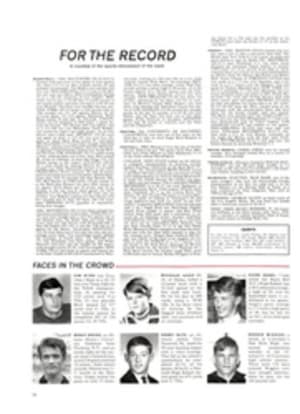
DEFENSE AND REX MAKE A KING
"The many theories of Big Game Winning in football echo through the sport like the growls of Woody Hayes. Big games are won on defense, it is said. Big games are won on preparation. Big games are won "up front"—with emotion, with momentum, by the better quarterback, by coaching, on the fewest mistakes, with field position, with the kicking game and sometimes by the One Great Scorer who comes to write against your face mask. And, finally, it is said that big games are usually lost and not won, but this is normally the lament of a loser. The truth is that big games are decided by a combination of these things, and the truest thing of all is that what should have happened in this season's Big Game, ahem, in fact, uh, did.
What should have happened in the Rose Bowl contest last week between No. 1 and No. 2 is that Ohio State should have beaten USC, 27 to 16. This final score is somewhat irrelevant because the game really ended on the third play of the fourth quarter when the Buckeyes roared ahead by 20-10. An additional Trojan mistake added to Ohio State's total, and an official's mistake donated a meaningless touchdown to USC at the end, but the big game really lasted only 46 minutes and eight seconds, which was the time elapsed when Rex Kern—the better quarterback—threw a scoring pass to put Ohio State up by 10.
With the wondrous O.J. Simpson running 80 smogfree yards to the foot of the Sierra Madre, USC had been a good enough team to take a 10-0 lead in the second period and offer up the possibility that this one peerless back might just be dazzling enough to overcome the team strength of Ohio State throughout the beautiful afternoon. But this was asking too much. It takes a strong team to chew its way back from 10 down to 10 ahead, and OSU was that strong any way you wanted to measure it.
Rex Kern proved to be a more effective quarterback than USC's Steve Sogge. Ohio State's corps of runners—Jim Otis, Leophus Hayden and Kern—counterbalanced O.J., and the Ohio State defense, front, back and sideways, made the big plays that USC's did not.
It is only the esthetics of football which says that the offense, not the defense, should make the turning-point play in such a game. It would have been seemly and thrilling if Simpson could have burst loose again, and if Ohio State could have won with a long drive at the finish—if, in other words, the game had not ended prematurely. That would have been the suspense drama that the Rose Bowl's 102,000 flag wavers and Nixon watchers might have been happier with. But the Ohio State defense was simply too impatient. When the Buckeyes' Bill Urbanik, an unesthetic tackle, rammed into Sogge's back, forcing him to fumble at his own 21-yard line, and when Vic Stottlemyer recovered for Ohio State, the play of the day had occurred. Not an 80-yard run or a leaping pass catch. Just a passer dropping back, being smothered and losing the ball. An ugly play, really; as unglamorous as Woody's white-fishnet jerseys but part of what football is all about—taking the ball away from the other team.
At this point the score was 13-10 Ohio State in an ultraclose, thoroughly stimulating affair that was as far from being settled as Columbus, O. is from Pasadena. No one could have been more aware than the suddenly desperate Trojans that to let Ohio State seize this opportunity to score, to jump ahead by 10, would be catastrophic. Nor was there any guarantee that USC would allow it to happen. Earlier, in the first quarter, the Buckeyes had driven to a first down at the Trojan 14, but Coach John McKay's forces had held.
Yet this could be the ball game, this fumble, and Rex Kern was personally going to see to it that it was. One of the first things Kern did was get away for a crucial gain on what Hayes calls his quarterback's "third dimension."
Kern drifted back to pass at the USC 18, saw himself being enclosed by crimson shirts on both sides and quickly looked for the third dimension—the open alley in the middle. It was there, so Rex ran. For 14 huge, golden yards he ran. Momentarily after this it seemed USC had a chance to escape by-giving up only a field goal, for two plays netted Ohio State zero. Now it was third down for the Buckeyes at the USC four-yard line. With McKay's defense dug in for the run, or perhaps the dropback pass, Kern had another key play—a first dimension. He faked the middle, rolled to his left and threw a perfect little pass to Leophus Hayden, his halfback, who had sneaked lonesomely into the left-hand corner of the end zone.
These two plays—the run and the pass, both in clutch moments—demonstrated Rex Kern's superiority at quarterback. He is a bigger, stronger, faster and more instinctive football player than USC's Steve Sogge, so Kern certainly should be a better quarterback. The amazing thing about Sogge is that he took the Trojans as far as he did. He is a kid that John McKay never thought would make it. But few coaches ever got more out of a player than McKay got out of Sogge, so he will just have to be excused for the Rose Bowl loss.
So will O.J. Simpson. The Heisman winner committed a pair of important errors during the afternoon, but they were not his two widely discussed fumbles. These did not hurt that much, although fumbles never help anything. One fumble came when the score was still tied, and Ohio State did not capitalize on it. The other came after the game was lost. What Simpson did do—which almost nobody noticed—was underestimate the speed of John Tatum, Ohio State's demon cornerback, on a swing pass that should have been a touchdown, and then on the same series he overthrew a cinch touchdown pass to End Ted DeKraai, the kind you complete to your 6-year-old son in the backyard.
These plays came on USC's initial significant drive. On the first, Simpson took the pass from Sogge for 16 yards down to the Ohio State three-yard line. He was breezing into the end zone, he thought, when out of nowhere flashed Tatum. The Buckeye sophomore saved four points, the difference between a touchdown and a field goal, by bouncing O.J. out of bounds. O.J. was not burning speed or he would have scored. He just didn't see Tatum coming, he said later, and he didn't know. Tatum was that fast, anyhow, although McKay respected the Buckeye defender by shaping his game plan to work away from him. Three plays later O.J. overthrew the pass, and USC came away with three points instead of seven.
This did not seem to matter much moments thereafter when O.J. got loose on a pitchout to the short side of the field, broke two tackles, faked a third man dizzy with a 180-degree cutback and sprinted 80 yards to a touchdown on the prettiest run of any Rose Bowl ever. It seemed then that O.J. was going to close out his splendid two years in the grandest of style.
He did, in fact, wind up with 171 yards, which is hardly an argument that Ohio State stopped him. He repeatedly kept the game rocking with good runs and pass catches. In his whole two years at USC he never stopped being the best collegiate runner that most of us have ever seen or will be seeing for quite a while.
But as the reign of O.J. ends, the reign of Ohio State's Woody Hayes and Rex Kern begins—or continues. Woody has been proving all season that the game has far from passed him by, and he made this unmistakably clear in Pasadena. His preparations were superb, right down to not letting his squad overeat or be over-impressed by the scenery, an attitude that outraged local boosters. Woody was tough in practice, and the California press thought even tougher with them. Offensively, he believed he could fun USC's middle, and he did. "We knew if they studied us, they'd want to stop us outside first, and they did a good job of it. But that gave us the inside running and the curl-in passes. They couldn't stop everything," he said.
Woody claimed, shortly before leaving on his annual visit with the troops in Vietnam, that he was not rattled or stunned when he trailed by 10 points. "We'd found out that we could run on 'em," he said. "And I didn't figure O.J. was going to break another one. I still thought we'd win."
One of the rather frightening aspects of the victory, for Ohio State's future opponents at least, is that Woody gets back Rex Kern and almost everybody else. True, he loses his big tackles, Dave Foley and Rufus Mayes, and a terrific linebacker, Mark Stier, and a few others from around the trenches, but Ohio State has never had a problem filling the trenches. Some of Woody's past teams looked like 11 tackles who had flipped a coin to see who took the snapbacks. But the throwers and the catchers and the runners and such superb defensive backs as Tatum and Mike Sensibaugh all come back to Woody for 1969 and most of them for 1970 as well. "They never made a mistake," said a discouraged USC player afterward. They may not for two more years.
THREE ILLUSTRATIONS
BERNARD FUCHS
Architects of victory were Quarterback Kern and Coach Hayes (left), but fatal damage was done by defense on key play (right) in which USC's Sogge (6) was hit by Urbanik (79) and ball was torn loose. OSU recovered and scored immediately.
ILLUSTRATION
BERNARD FUCHS
Simpson highlighted his day with this move on 80-yard TD run, a sharp cut to right that fooled OSU's Mark Debevc (83) and Jim Stillwagon (68).
ILLUSTRATION
BERNARD FUCHS
But O.J. had his dark moments, too, including this fumble of a short pass after being hit by Mark Stier (54). Mike Polaski (15) recovered for OSU.

